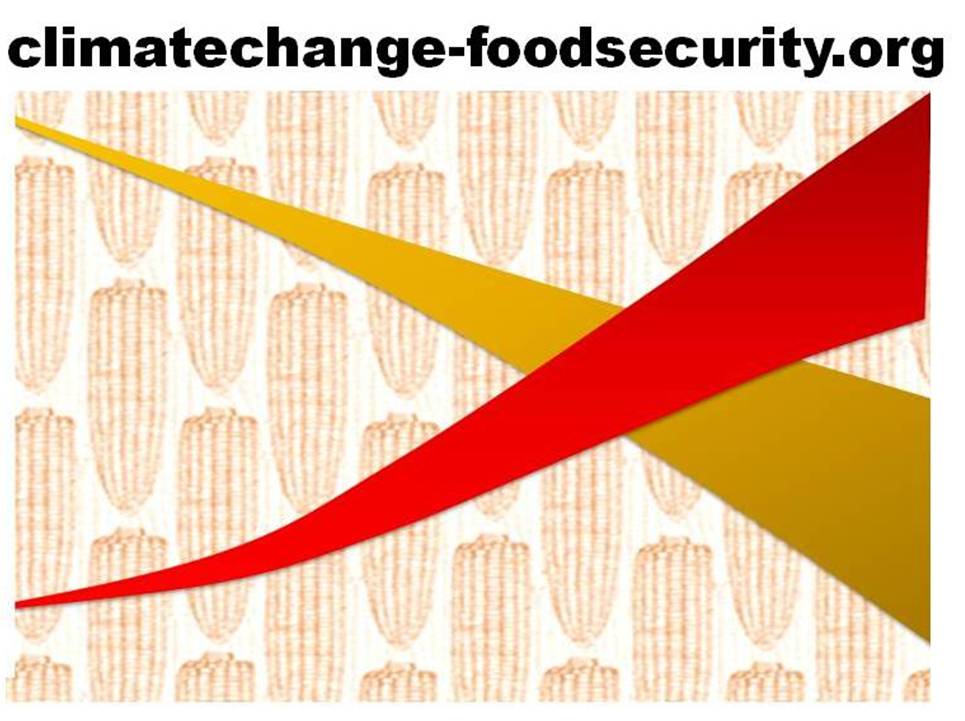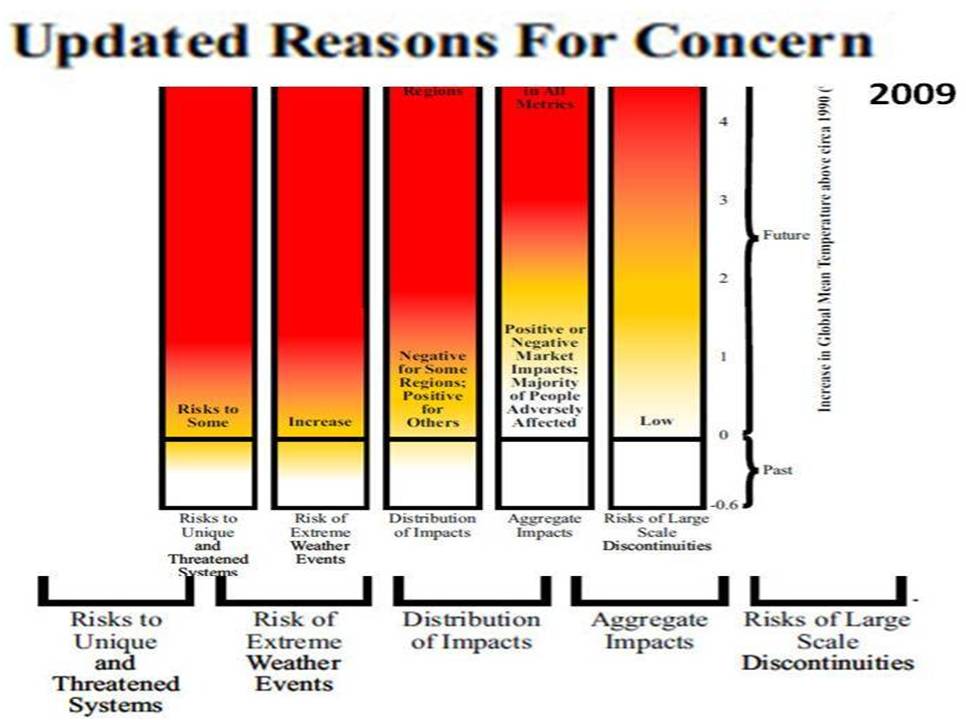
Climate Change and Food Security

Policy making
The absolute limit of crop tolerance in all regions is a global average temperature increase of 3.0C (see NRC and IPCC). Therefore we are today committed to a temperature increase that will result in reducing yields of the world's food supply and productivity in all regions. We are in a dire global emergency with respect to our food security, and it's being completely ignored.
Due to the number of highly significant inevitable adverse impacts which are not included or inadequately included in the climate crop models, the assessment results given by the scientists should be assumed to be largely under estimates.
The 2010 national research council assessment points this out by saying the following:
The expected impacts are useful as a measure of the likely direction and magnitude of average yield changes, but fall short of a complete risk analysis which would, for instance, estimate the chance of exceeding critical thresholds.
The 2010 national research council assessment points this out by saying the following:
The expected impacts are useful as a measure of the likely direction and magnitude of average yield changes, but fall short of a complete risk analysis which would, for instance, estimate the chance of exceeding critical thresholds.
The climate change scientists develop computer models and run experiments for the interactions between a limited number of variables on crop yields for a very limited number of crops. From these computer model results the IPCC assessments provide policy makers the apparent effects of a range of global temperature increases and climate changes on crop yields in different parts of the world.

The scientists who designed the computer models for climate and crops, use the regional temperature increase as a surrogate for the CO2 fertilization benefit and the limited number of model adverse impacts.
They take a particular regional temperature increase and they correlate that with the atmospheric CO2 increase and adverse impacts of the higher temperature.
This ignores the long term cumulative impacts of degradation on the agricultural land caused by global climate change.
If food security for humanity (all future generations) were a top concern in policy making there is another huge problem arising from the models.
That problem is the lag effect of an increase in the atmospheric carbon dioxide concentration and the full amount of global temperature increase caused by it. This fundamental aspect of the climate science is accounted for in policy considerations for estimating climate safety climate change danger- except for food security.
At any particular time, in the situation of continuing greenhouse gas emissions and continuing increase in atmospheric carbon dioxide, the global average temperature increase does not fully reflect the increased atmospheric carbon dioxide concentration at that time. The full amount of global temperature increase 'commitment' is practically double the temperature increase at that point in time.
They take a particular regional temperature increase and they correlate that with the atmospheric CO2 increase and adverse impacts of the higher temperature.
This ignores the long term cumulative impacts of degradation on the agricultural land caused by global climate change.
If food security for humanity (all future generations) were a top concern in policy making there is another huge problem arising from the models.
That problem is the lag effect of an increase in the atmospheric carbon dioxide concentration and the full amount of global temperature increase caused by it. This fundamental aspect of the climate science is accounted for in policy considerations for estimating climate safety climate change danger- except for food security.
At any particular time, in the situation of continuing greenhouse gas emissions and continuing increase in atmospheric carbon dioxide, the global average temperature increase does not fully reflect the increased atmospheric carbon dioxide concentration at that time. The full amount of global temperature increase 'commitment' is practically double the temperature increase at that point in time.

Carbon dioxide, unlike the other global warming greenhouse gases has a beneficial property for plant growth. That's because plants utilized the carbon dioxide in the air, making their own energy from the carbon and sunlight. Potentially therefore there is a so-called carbon dioxide fertilization effect of increasing the ambient carbon dioxide.
The trouble is increasing the carbon dioxide is the big cause of global warming and climate disruption. Climate disruption of course is damaging crops as is too much heat.
So under a situation of uncontrolled greenhouse gas pollution and global warming, which is our current situation, any beneficial effect from carbon dioxide fertilization will at best be short lived, by being overwhelmed by all the adverse effects on plant reproduction and growth caused by the same carbon dioxide increase (global warming).
The trouble is increasing the carbon dioxide is the big cause of global warming and climate disruption. Climate disruption of course is damaging crops as is too much heat.
So under a situation of uncontrolled greenhouse gas pollution and global warming, which is our current situation, any beneficial effect from carbon dioxide fertilization will at best be short lived, by being overwhelmed by all the adverse effects on plant reproduction and growth caused by the same carbon dioxide increase (global warming).

Today's global average temperature increases O.8° C.
Today's absolute temperature increase commitment is 1.4° C which is due to a heat lag from the oceans. Most scientists say we already committed to an increase of above 2° C. Recent published science puts our commitment today as high as 2.4° C
So if a policy maker wanted to avoid exposing the future of the world's food production to a global average temperature increase of 3°C, calculating this from the climate crop model results for 3° C will not work.
The policy will have to be based on preventing a temperature increase of 1.5° C (or much less) no matter how beneficial the carbon dioxide fertilization effect might look.
Today's absolute temperature increase commitment is 1.4° C which is due to a heat lag from the oceans. Most scientists say we already committed to an increase of above 2° C. Recent published science puts our commitment today as high as 2.4° C
So if a policy maker wanted to avoid exposing the future of the world's food production to a global average temperature increase of 3°C, calculating this from the climate crop model results for 3° C will not work.
The policy will have to be based on preventing a temperature increase of 1.5° C (or much less) no matter how beneficial the carbon dioxide fertilization effect might look.
Today's already absolute committed global average temperature increase 1.4° C. Commitment according to climate models is 2.0° C to 2.4° C
The only global warming climate change limit we have is a policy number that originated with the EU in 1996. This was to avoid a global temperature of above 2°C.
Policy making is hampered by the IPCC not actually making any statement on dangerous interference.
In the international policy making and United Nations climate change negotiations, the risks to food security from global warming and climate change are simply not on the agenda. The reason is that risks and impacts to agricultural crop yields is not explicitly listed as a danger or a 'Reason For Concern' by the intergovernmental panel on climate change assessment.
The global climate change science does not give a high priority to agriculture in terms of the dangers from global climate change.
Policy making is hampered by the IPCC not actually making any statement on dangerous interference.
In the international policy making and United Nations climate change negotiations, the risks to food security from global warming and climate change are simply not on the agenda. The reason is that risks and impacts to agricultural crop yields is not explicitly listed as a danger or a 'Reason For Concern' by the intergovernmental panel on climate change assessment.
The global climate change science does not give a high priority to agriculture in terms of the dangers from global climate change.
The reason for not recognizing the impacts of global warming and climate change to Food Security as a top priority danger is that the IPCC assessed that world hunger would be reduced even in the presence of increasing global climate change by the assumed beneficial effect of world economic growth on future Food Security.
There are over a billion of malnourished people in the world now for the first time, but the IPCC assessment based on the economic argument concludes that by 1980 this will only be 100 to 240 million.
... moreover to climate change is likely to further shift the regional focus on food insecurity to sub-Saharan Africa. By 2080 about 75% of all people at risk of hunger are estimated to live in this region ... the magnitude of these climate impacts will be small compared with the impacts of socio-environmental development.
... studies suggest that economic growth and slowing population growth project projected for the 21st century will globally significantly reduce the number of people at risk of hunger in 2080 from current levels. Fisher 2002 a,b and Parry 2004, 2005 estimate reductions by more than 75% by 2080, or by about 560 to 700 million people, thus projecting a global total of 100 to 240 million undernourished by 2080 (A1 B1,B2).
IPCC 2007 WG 2 Impacts www.ipcc.ch./publications_and_data/ar4/wg2/en/ch5s5-8.html
There are over a billion of malnourished people in the world now for the first time, but the IPCC assessment based on the economic argument concludes that by 1980 this will only be 100 to 240 million.
... moreover to climate change is likely to further shift the regional focus on food insecurity to sub-Saharan Africa. By 2080 about 75% of all people at risk of hunger are estimated to live in this region ... the magnitude of these climate impacts will be small compared with the impacts of socio-environmental development.
... studies suggest that economic growth and slowing population growth project projected for the 21st century will globally significantly reduce the number of people at risk of hunger in 2080 from current levels. Fisher 2002 a,b and Parry 2004, 2005 estimate reductions by more than 75% by 2080, or by about 560 to 700 million people, thus projecting a global total of 100 to 240 million undernourished by 2080 (A1 B1,B2).
IPCC 2007 WG 2 Impacts www.ipcc.ch./publications_and_data/ar4/wg2/en/ch5s5-8.html

The one relevance to food security in the IPCC 'reasons for concern' is 'extreme weather events' and important though that is the reason for concern should be food security but food security is not identified.
Policy